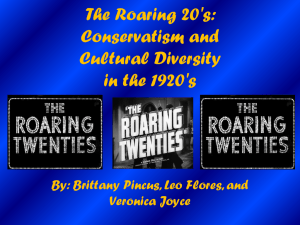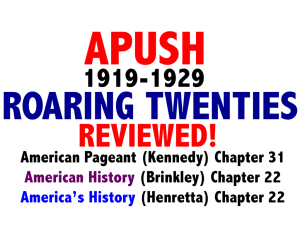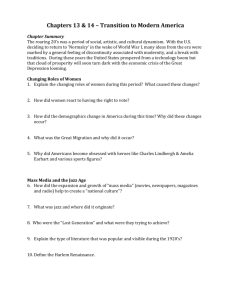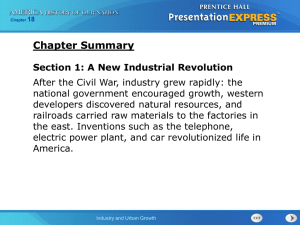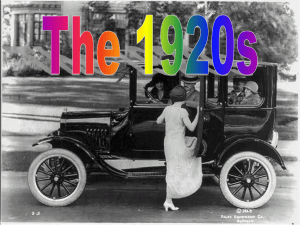File - US Studies
advertisement
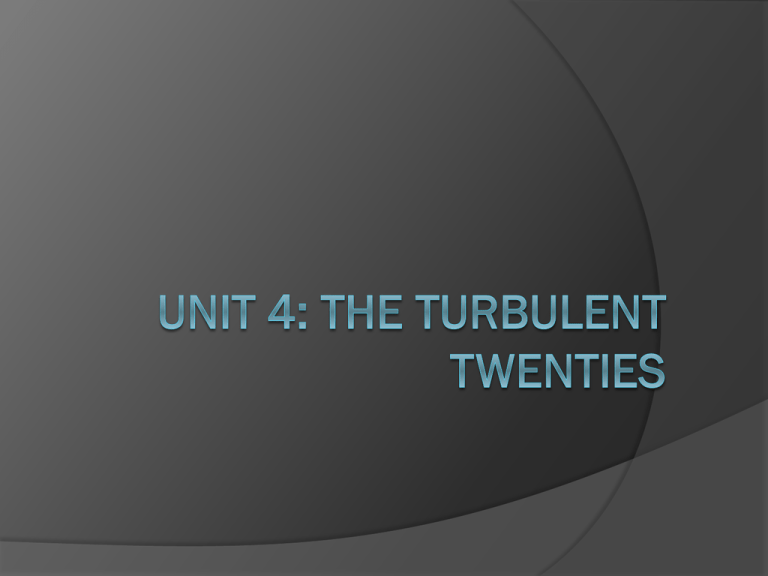
1920s: Jazz Age/ Roaring Twenties Overall, a reaction against what went on in Units 2 and 3 US tired of imperialism, war, sacrifice Desire to get to “Normal” People tired of progressive ideas of early 1900s Characteristics of “Normalcy” Conservative: Back to how America used to be Get most out of life: Carefree, optimistic, confident Isolation/PeaceUS does not sign Treaty or join League of Nations Laissez-Faire=profits, big business Prosperity/individual opportunity Traditional values (conformity) Rep. Party in power (Wilson=Dem) BUT… The 1920s will not be “normal” Stock Market Crash: October 29, 1929 DEPRESSION Desire to return “Normal”…BUT PostWar Troubles… Demobilization: Normal, however… 4.5 million soldiers return Women lose jobs Buying spree=shortages=prices double Recession 1920-1921 ○ Prices fall, factories cut back, fire workers Farm crisis=prices fall=debt ○ 12% Unemployment $2 Billion government contracts from war gone Labor Problems Protests and strikes 1919: 3,600 work stoppages involve 4 million workers ○ ○ ○ ○ Seattle: 36,000 shipyard workers Boston: Police strike Penn: 365,000 steel workers United Mine Workers: 400,000 Negative spin-off effectbusinesses shut downlay off workersreasons to strike Labor Problems, cont’d… Blamed on communists, socialists, radicals and immigrants in unions Red Scare Bolshevik Revolution (Russia) 1917 Lenin Radicals (commies) ran unions Role of Communist International Socialist Party in US, 1901: Eugene Debs A. Mitchell Palmer US Attorney General Palmer Raids: To round up immigrants and “radicals” Arrests Deportations Sacco-Vanzetti Trial (1920) Robbery 1920Executed 1927 Judge Webster Thayer Republicans in Power 1920 Election: Warren Harding: Probusiness platform, cut US debt, promote economic growth Charles Dawes: Spending cuts Fordney-McCumber Tariff Andrew Mellon: Tax cuts for rich = Trickle Down Effect Impact of Republican Policies Positive impact on business Business profits up 60% Negative impact on workers 1920: 5 million workers in unions 1923: 3.6 million workers in unions “Yellow dog” contracts Negative impact on farmers Prices drop, overseas purchases drop, debt New Directions for Women Positive and negative 19th Amendment passed Equal Rights Amendment NOT approved ○ Is the right to vote enough? ○ Mary Anderson=Yes ○ Alice Paul=No Political Scandals and Laissez-Faire Teapot Dome Scandal 1921 Veterans Bureau Scandal 1923 Charles Forbes 1924 Election Calvin Coolidge: “Silent Cal,” continue with Republican ideas and “back to normal” “The business of America is business” Revenue Act of 1926 – tax cuts rich Cuts in government spending = No government welfare 1928 Election Herbert Hoover: Continue with Republican ideas and “back to normal” Alfred E. Smith was the Democratic candidate Gov. of New York Supported by liberals, immigrants, Catholics A Nation Divided But this was supposed to a nice, calm, easy, tranquil and serene decade… Racial Divisions Even though 13th, 14th, 15th Amendments African-American migration north ○ 800,000 in1920s/2.5 million by 1930 Racial and economic tensions ○ 25 race riots throughout US by 1919 KKK 1915 (William J. Simmons) ○ 5 million members by mid 1920s Nationality Divisions: “Nativism” Immigration Act of 1924: Quota system/2% rule Xenophobia yet 25% of Americans born overseas Immigrants =/= “American” Fear of economic competition Fear of “radicals” and “commies” Red Scare Even fear of Native Americans trying to assimilate ○ ○ Dawes Act of 1884: Give Indians farm land Poverty issues Yet…Some Advances NAACP Anti-lynching Committee (est. 1909) A. Philip Randolph: Union Work Black Nationalism: Marcus Garvey Brotherhood of Sleeping Car Porters United Negro Improvement Association (est. 1914) Back to Africa Movement Previous work by W.E.B. DuBois and B.T. Washington Overall… A major class of values = polarization Urban v. rural Young v. old Liberal v. conservative “wet” v. “dry” Rich v. poor Tradition v. new ideas Boom Times: Prosperity and Productivity Republican policies seem to be working: ConfidenceInvesting Business expansion: GNP up to $100 billion by 1929 ○ Purchasing power 32% ○ Use of electricity (2/3 of homes) Scientific Management techniques ○ Fred Taylor: Delegating tasks Henry Ford Henry Ford: Assembly line Car=$850 in 1909, $250 in 1924 Increase in production=lower production costs=lower price for cars = sell more cars = need more production http://www.history.com/shows/americathe-story-of-us/videos/henry-ford-andthe-model-t#henry-ford-and-the-model-t Changes in Workplace The industrial factory worker does not seem to benefit Immigrants seen as un-American ○ Boring, repetitive work ○ Dangerous conditions ○ Long hours, low wages Changes in Lifestyle Example of spin-off More cars=more roads=a more migratory society: More mobility: Geographically and socially More travel=new areas grow Social life: Young people getting away from home Changes in Lifestyle New buying habits Alfred P. Sloan (head of G.M.) ○ Installment buying plans ○ Planned obsolescence ○ Advertising: “New and Improved!” Life in the Twenties On the surface: “Lots of fun” Beneath: A clash of values and ideas Prohibition Part of progressive reforms: Combat poverty, violence, poor health, absenteeism from work ○ 18th Amendment (January 1919) ○ Volstead Act (October 1919) Yet, actually increased crime ○ Organized mobs: Al Capone ○ Bootlegging and speakeasies ○ Law abiding folks = criminals Youth Culture Again, clash of values Generations: Conservative v. Liberal lifestyles Women = “Flappers” defied traditions College kids = wild times (Crazy kids) Leisure time = fun fads (idiots) Mass Entertainment More money to spend Radio: KDKA Pittsburgh Movies: ○ Cecil B. DeMille ○ Al Jolson: “talkies” ○ BUT censorship (Will Hays) Sports heroes: Babe Ruth, Jim Thorpe Cultural heroes: Charles Lindbergh, Amelia Earhart Religious Revival A conservative response to this fun Scopes Trial 1925: Clarence Darrow v. William J. Bryan Trial about free expression v. religious ideas over the issue of evolution as developed by Darwin Overall… What was supposed to be a “comfortable” decade was really a decade of discomfort and inconsistencies A Creative Era Music: JAZZ: Stars in New Orleans Like the migration of people, it works its way North ○ St. Louis, Memphis, Kansas City, Chicago, NYC ○ New ideas = New art (music) Reflects cultural diversity The nation/music was diverse This bothered some traditionalists A Creative Era, cont’d… Harlem Renaissance: Expression of black culture/pride (cultural freedom) Self Expression=Racial Expression ○ Pan Africanism Music, art, literature, theater http://www.youtube.com/watch?v=h4ZyuULy 9zs Literature: The “Lost Generation” Reaction against World War I Middle Class Consumerism = Conformity Disillusionment with USA ○ F. Scott Fitzgerald ○ Ernest Hemingway ○ Sinclair Lewis ○ H.L. Mencken Visual Arts Show life of urbanization and industrialization Edward Hopper: Art should reflect the experiences of modern life
